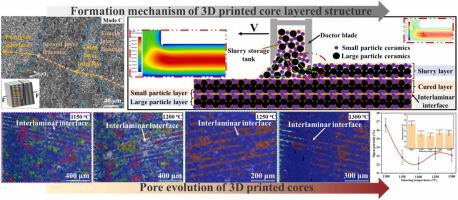Additive Manufacturing ( IF 10.3 ) Pub Date : 2022-07-22 , DOI: 10.1016/j.addma.2022.103055 Qiaolei Li , Weiqiang Hou , Jingjing Liang , Chaowei Zhang , Jinguo Li , Yizhou Zhou , Xiaofeng Sun

|
The ceramic cores used in advanced aero-engine blades are becoming increasingly complex. Vat photopolymerisation 3D printing core technology has been used to compensate for the limitations of traditional hot-injection processes in the preparation of complex cores. However, 3D printed cores exhibit anisotropy of strength and sintering shrinkage, which requires further research and development. Herein, ceramic core samples were prepared from the X, Y, and Z directions using vat photopolymerisation 3D printing technology, and the anisotropic behaviour was systematically studied. The mechanism of core delamination was studied using a finite element simulation of slurry spreading during the printing process. In the slurry spreading process, the flow rate of the slurry middle layer was faster than that of the upper and lower surfaces, and fine particles concentrated more easily on the upper and lower surfaces. The interface between the layers was composed of fine particles. The interfacial sintering was compact and the pores were small. The interior of the lamellar structure was composed of coarse particle with large and dispersed pores. In addition, the distribution of pores within the 3D printed core presents an evolution law during the sintering process. With an increase in the sintering temperature, the pores move toward the interface between the layers and are enriched, and the pores coalesced to form larger pores at the interface. When sintered at high temperatures, the interfacial pores formed a gradient line between the porous layers. The combination of finite element simulation and experimentation provides theoretical guidance for the control of the layered structure and anisotropy of 3D printed cores. This promotes the application of 3D printed ceramic technology in the industrial field.
中文翻译:

控制 3D 打印陶瓷芯的各向异性行为:从层内颗粒分布到层间孔隙演化
先进航空发动机叶片中使用的陶瓷芯变得越来越复杂。大桶光聚合 3D 打印核心技术已被用于弥补传统热注射工艺在制备复杂核心方面的局限性。然而,3D打印型芯表现出强度和烧结收缩率的各向异性,这需要进一步的研究和开发。在此,使用还原光聚合 3D 打印技术从 X、Y 和 Z 方向制备陶瓷芯样品,并系统地研究了各向异性行为。使用在印刷过程中浆料扩散的有限元模拟来研究核心分层的机制。在浆料铺展过程中,浆料中间层的流速快于上下表面的流速,细颗粒更容易集中在上下表面。层之间的界面由细颗粒组成。界面烧结致密,气孔小。层状结构内部由粗大颗粒组成,孔隙大且分散。此外,3D打印芯内的孔隙分布在烧结过程中呈现出演化规律。随着烧结温度的升高,孔隙向层间界面移动并富集,孔隙在界面处聚结形成较大的孔隙。当在高温下烧结时,界面孔隙在多孔层之间形成梯度线。有限元仿真与实验相结合,为3D打印磁芯的层状结构和各向异性控制提供了理论指导。这促进了3D打印陶瓷技术在工业领域的应用。















































 京公网安备 11010802027423号
京公网安备 11010802027423号